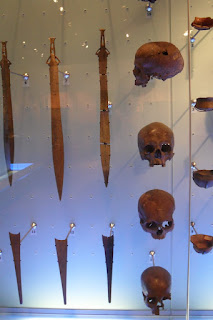
This exhibit displays the notion of "London before London" in a very effective manner. It is the largest urban history museum in the world, and has over 400,000 visitors each year. The goal of the display is to convey the message of people through evidence, the river-and it's spectacular finds, climate change and atmosphere, and the legacy this has left behind. It focuses on people as individuals, place and landscape. People generally don't recognize these elements when they think of pre-history. Also, schools in this area do not cover pre-history!! Their lessons begin with the Roman invasion, which I thought was very interesting. London before London encompasses the time periods of 450,000 BC- AD 50.
The museum is laid out so you walk along the River Wall and view the items that have been found in the river through time and see how life progressed since 450,000 BC. The other side of the wall is the Landscape Wall. It was interesting to see the development of London through time in displays such as Carving out A Home 4000-1500BC, to Moving Beyond the Valley 700BC-AD 50.

Some of the things that really impacted me and brought out the intended message were the skulls and weapons dated from 1300-1000 BC. It is incredible to think that these skulls were people like us once and that we look like that underneath. Another item was a piece of wood from the first London Bridge dating from 1700-1200 BC. It is humbling to know we are not the first, and will not be the last. It makes me wonder if people from the past thought they would have this much of an impact on the future, or be held in such high regard.
 This tablet is from the Old London Bridge and says 'Annodni/1509'. The bridge was supported by the income it received from renting 139 houses and shops, tolls, and private donations.
This tablet is from the Old London Bridge and says 'Annodni/1509'. The bridge was supported by the income it received from renting 139 houses and shops, tolls, and private donations.
 This little piece of history is part of the remains of a fort built by the Romans when London was called Londinium. It was used not only as a fort, but mainly as a home for the soldiers since they did not live with civilians. It was only discovered in the 1950s.
This little piece of history is part of the remains of a fort built by the Romans when London was called Londinium. It was used not only as a fort, but mainly as a home for the soldiers since they did not live with civilians. It was only discovered in the 1950s.
The museum is laid out so you walk along the River Wall and view the items that have been found in the river through time and see how life progressed since 450,000 BC. The other side of the wall is the Landscape Wall. It was interesting to see the development of London through time in displays such as Carving out A Home 4000-1500BC, to Moving Beyond the Valley 700BC-AD 50.

Some of the things that really impacted me and brought out the intended message were the skulls and weapons dated from 1300-1000 BC. It is incredible to think that these skulls were people like us once and that we look like that underneath. Another item was a piece of wood from the first London Bridge dating from 1700-1200 BC. It is humbling to know we are not the first, and will not be the last. It makes me wonder if people from the past thought they would have this much of an impact on the future, or be held in such high regard.
 This tablet is from the Old London Bridge and says 'Annodni/1509'. The bridge was supported by the income it received from renting 139 houses and shops, tolls, and private donations.
This tablet is from the Old London Bridge and says 'Annodni/1509'. The bridge was supported by the income it received from renting 139 houses and shops, tolls, and private donations. This little piece of history is part of the remains of a fort built by the Romans when London was called Londinium. It was used not only as a fort, but mainly as a home for the soldiers since they did not live with civilians. It was only discovered in the 1950s.
This little piece of history is part of the remains of a fort built by the Romans when London was called Londinium. It was used not only as a fort, but mainly as a home for the soldiers since they did not live with civilians. It was only discovered in the 1950s. There are some really great resources on the museum's website.
Get a close up of this incredible wall by visiting: http://www.museumoflondon.org.uk/learning/features_facts/digging/army/s1.html
Check the rest of the museum out too! http://www.museumoflondon.org.uk/English/
Check the rest of the museum out too! http://www.museumoflondon.org.uk/English/
No comments:
Post a Comment